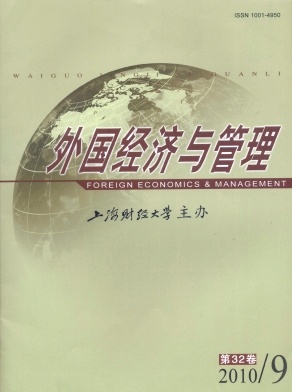国外团队跨界行为研究回顾与展望
外国经济与管理 2010 年 第 32 卷第 09 期, 页码:10 - 15
摘要
参考文献
摘要
团队跨界行为既是组织行为学研究的热点又是重要的现实问题,深入理解团队跨界行为是提高团队效能的必要前提。本文对有关团队跨界行为的已有研究进行了系统回顾,对跨界行为的概念及其测量、跨界行为的主要研究视角以及前因和结果研究进行了梳理,并对未来相关研究的发展方向进行了展望,以期为有效管理团队跨界行为提供理论依据。
[1]Ancona,D G.Outward bound:Strategies for teamsurvival in organizations[J].Academy of Management Journal,1990,33(2):334-365.
[2]Ancona,D G,and Caldwell,D F.Demography and design:Predictors of newproduct teamperformance[J].Organization Science,1992a,3(3):321-341.
[3]Tortoriello,M,and Krackhardt,D.Activating cross-boundary knowledge:The role of si mmeliantiesinthe generation of innova-tions[J].Academy of Management Journal,2010,53(1):167-181.
[4]Choi,J M.External activities and teameffectiveness:Review and theoretical development[J].Small Group Research,2002,33(2):181-208.
[5]Marrone,J A,Tesluk,P E,and Carson,J B.A multilevel investigation of antecedents and consequences of team member bound-ary-spanning behavior[J].Academy of Management Journal,2007,50(6):1 423-1 439.
[6]Ancona,D,and Caldwell,D F.Bridgingthe boundary:External activity and performancein organizational teams[J].Administra-tive Science Quarterly,1992b,37(4):634-665.
[7]Bettencourt,L A,Brown,S W,and MacKenzie,S B.Customer-oriented boundary-spanning behavior:Test of a social exchangemodel of antecedents[J].Journal of Retailing,2005,81(2):141-157.
[8]Bettencourt,L A,and Brown,S W.Role stressors and customer-oriented boundary-spanning behaviors in service organizations[J].Journal of the Academy of Marketing Science,2003,31(4):394-408.
[9]Druskat,V U,and Wheeler,J V.Managingfromthe boundary:The effectiveleadership of self-managing workteams[J].Acade-my of Management Journal,2003,46(4):435-457.
[10]Gittell,J H.Coordinating mechanisms in care provider groups:Relational coordination as a mediator andinput uncertainty as amoderator of performance effects[J].Management Science,2002,48(12):1 408-1 426.
[11]Keller,R T.Cross-functional project groups in research and new product development:Diversity,communications,job stress,and outcomes[J].Academy of Management Journal,2001,44(3):547-555.
[12]Johlke,MC,and Duhan,D F.Supervisor communication practices and boundary spanner role ambiguity[J].Journal of Manage-rial Issues,2001,13(1):87-102.
[13]Choi,J M.Crisis management in organizational teams:The effect of internal and external activities[R].Paper presented at the10th annual convention of the American Psychological Society,Washington,DC,1998.
[14]Leifer,R,and Delbecq,A.Organizational environmental interchange:A model of boundary spanning activity[J].Academy ofManagement Review,1978,3(1):40-52.
[15]Tushman,M,and Scanlan,TJ.Boundary spanningindividuals:Their roleininformationtransfer andtheir antecedent[J].Acad-emy of Management Journal,1981,24(2):289-305.
[16]Bresman,H.External learning activities and team performance:A multi method field study[J].Organization Science 2010,21(1):81-96.
[17]Faraj,S,and Yan,A.Boundary workin knowledge teams[J].Journal of Applied Psychology,2009,94(3):604-617.
[18]Fleming,L,and Waguespack,D M.Brokerage,boundary spanning,andleadershipin openinnovation communities[J].Organi-zation Science,2007,18(2):165-184.
[19]Tortoriello,Marco,and Krackhardt,David.Activating cross-boundary-knowledge:The role of si mmelian ties in the generation ofinnovation[J].Academy of Management Journal,2010,53(1):167-181.
[20]Joshi,A,Pandey,N,and Han,G H.Bracketing teamboundary spanning:An examination of task-based,team-level,and con-textual antecedents[J].Journal of Organizational Behavior,2009,30(6):731-759.
[2]Ancona,D G,and Caldwell,D F.Demography and design:Predictors of newproduct teamperformance[J].Organization Science,1992a,3(3):321-341.
[3]Tortoriello,M,and Krackhardt,D.Activating cross-boundary knowledge:The role of si mmeliantiesinthe generation of innova-tions[J].Academy of Management Journal,2010,53(1):167-181.
[4]Choi,J M.External activities and teameffectiveness:Review and theoretical development[J].Small Group Research,2002,33(2):181-208.
[5]Marrone,J A,Tesluk,P E,and Carson,J B.A multilevel investigation of antecedents and consequences of team member bound-ary-spanning behavior[J].Academy of Management Journal,2007,50(6):1 423-1 439.
[6]Ancona,D,and Caldwell,D F.Bridgingthe boundary:External activity and performancein organizational teams[J].Administra-tive Science Quarterly,1992b,37(4):634-665.
[7]Bettencourt,L A,Brown,S W,and MacKenzie,S B.Customer-oriented boundary-spanning behavior:Test of a social exchangemodel of antecedents[J].Journal of Retailing,2005,81(2):141-157.
[8]Bettencourt,L A,and Brown,S W.Role stressors and customer-oriented boundary-spanning behaviors in service organizations[J].Journal of the Academy of Marketing Science,2003,31(4):394-408.
[9]Druskat,V U,and Wheeler,J V.Managingfromthe boundary:The effectiveleadership of self-managing workteams[J].Acade-my of Management Journal,2003,46(4):435-457.
[10]Gittell,J H.Coordinating mechanisms in care provider groups:Relational coordination as a mediator andinput uncertainty as amoderator of performance effects[J].Management Science,2002,48(12):1 408-1 426.
[11]Keller,R T.Cross-functional project groups in research and new product development:Diversity,communications,job stress,and outcomes[J].Academy of Management Journal,2001,44(3):547-555.
[12]Johlke,MC,and Duhan,D F.Supervisor communication practices and boundary spanner role ambiguity[J].Journal of Manage-rial Issues,2001,13(1):87-102.
[13]Choi,J M.Crisis management in organizational teams:The effect of internal and external activities[R].Paper presented at the10th annual convention of the American Psychological Society,Washington,DC,1998.
[14]Leifer,R,and Delbecq,A.Organizational environmental interchange:A model of boundary spanning activity[J].Academy ofManagement Review,1978,3(1):40-52.
[15]Tushman,M,and Scanlan,TJ.Boundary spanningindividuals:Their roleininformationtransfer andtheir antecedent[J].Acad-emy of Management Journal,1981,24(2):289-305.
[16]Bresman,H.External learning activities and team performance:A multi method field study[J].Organization Science 2010,21(1):81-96.
[17]Faraj,S,and Yan,A.Boundary workin knowledge teams[J].Journal of Applied Psychology,2009,94(3):604-617.
[18]Fleming,L,and Waguespack,D M.Brokerage,boundary spanning,andleadershipin openinnovation communities[J].Organi-zation Science,2007,18(2):165-184.
[19]Tortoriello,Marco,and Krackhardt,David.Activating cross-boundary-knowledge:The role of si mmelian ties in the generation ofinnovation[J].Academy of Management Journal,2010,53(1):167-181.
[20]Joshi,A,Pandey,N,and Han,G H.Bracketing teamboundary spanning:An examination of task-based,team-level,and con-textual antecedents[J].Journal of Organizational Behavior,2009,30(6):731-759.
引用本文
薛会娟. 国外团队跨界行为研究回顾与展望[J]. 外国经济与管理, 2010, 32(9): 10–15.
导出参考文献,格式为:





 7310
7310  850
850

